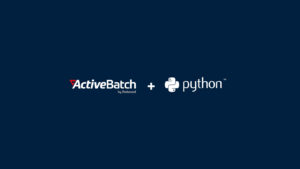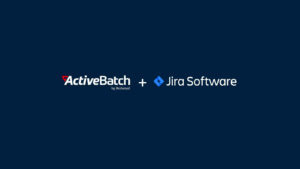No-Code Workflow Automation: A Full Explainer
Discover the myriad benefits of no-code workflow automation with ActiveBatch. This page covers what no-code workflow automation is, its benefits, and real-world use cases, as well as how ActiveBatch stacks up against competitors.

Not everyone can — or should be — a programmer. But everyone should be able to build and automate workflows. That’s why low-code and no-code platforms are so valuable to every enterprise: They enable business users to automate business processes with full functionality in a drag-and-drop interface. Let’s explore what no-code workflow automation is; discover its benefits and key concepts; and demonstrate real-world use cases.
What is No-Code Workflow Automation?
No-code workflow automation is the process of automating business workflows and tasks without needing traditional programming or coding. It enables users of all levels of technical expertise to create, modify, and execute automated workflows across business applications.
As enterprises continually assess how to improve efficiency, enhance productivity, and optimize resources, no-code solutions have thrived. Process automation tools can eliminate the need for manual, repetitive tasks and empower teams to adapt and respond to changing business needs with agility. Because these tools are easy to use and many offer templates, the learning curve is short for so-called “citizen developers.”
No-code automation solutions also help technical teams; as business users are able to build their own workflows, so IT teams spend less time building workflows and giving approvals.
Benefits of Low-Code Workflow Automation Tools
No-code and low-code tools provide many tangible benefits for organizations of all sizes, from small businesses to enterprises. Increased efficiency. Here are the primary benefits.
Increased Efficiency and Productivity
Workflow automation by nature reduces the time and effort required to complete previously manual, repetitive tasks. This automation helps businesses eliminate bottlenecks and reduce errors, increasing efficiency and productivity. And because low- and no-code tools like ActiveBatch often have many integrations, users can easily work among their existing tools from a central dashboard. Uniting every tool and platform streamlines process management and enterprise-wide workflows.
Better Data and Compliance
Because automated workflow management decreases errors, data quality soars. With better consistency and accuracy, teams get real-time access to improved, up-to-date information. This can aide data-based decision-making. Resulting error reduction also improves compliance, ensuring fewer mistakes are made and providing audit-ready job logs.
Enhanced Scalability and Flexibility
As organizations grow or business demands change, workflow automation enables teams to scale their operations with speed and ease. The no-code aspect of automation helps teams easily adapt workflows to change without extensive (or expensive) coding or reconfiguration. And a platform and environment-agnostic tool like ActiveBatch means there’s no disruption to your existing processes and no rip-and-replace.
Cost Savings
Decreased operational costs can come from many facets of automation. It could be increased productivity from software development teams who focus on high-value deliverables. It could come from Sales teams who automate Salesforce and CRM processes and follow up more quickly and effectively with leads. A single low-code automation solution like ActiveBatch can also decrease tooling overlap and get all tools to talk to each other. This streamlines tools and frees up more budget.
Getting Started
Before anyone builds anything, define the goals and requirements of each workflow. You’ll want to understand the desired outcomes, KPIs, and the specific tasks and actions that need automation. This will ensure the workflow is aligned with business objectives.
No-Code Automation Use Cases
To maximize the benefits of no-code software for workflow automation, businesses should identify tasks that are:
- Repetitive
- Rule-based
- Prone to human error
Streamline Customer Onboarding
A no-code automation platform is perfect for automating workflows like new customer onboarding. Whereas original processes may focus heavily on manual data entry, disjointed communication, and/or lengthy onboarding cycles, automated processes make onboarding easier for the organization and the new customer.
By integrating with the business’ CRM systems, request or ticketing systems, and other apps, workflow automation software can send automatic emails, manually input customer information, and even provide notifications to the correct person when it’s time for them to interact with new customers.
Automate the Approvals Process
No-code development for workflow automation enables teams to design and create a visual workflow to automate end-to-end project workflows. With a solution like ActiveBatch, teams can define triggers (such as project submission or modification) and configure actions to route the request to the appropriate stakeholders. This streamlines project management and speeds up the entire approvals process.
For many businesses, workflow automation with no-code platforms is the next step in their digital transformation. No-code apps for workflow automation have become game-changers in the modern business landscape. Because teams can automate complex processes without the need for coding skills, they get all the benefits of efficiency, productivity, and operational excellence.
Frequently Asked Questions
No-code workflow automation works best with processes that are repetitive, rule-based, and prone to human error. This might include data entry, form submissions, report generation, expense approvals, welcome communications, task assignments, ticket routing and escalation, document management, incident management, and more.
Learn more about the benefits of advanced workflow automation with ActiveBatch.
ActiveBatch is a no-code workflow automation tool that provides prebuilt connectors with the most popular, most-used enterprise applications. There is a large library of production-ready Job Steps and automated integrations and low-code API accessibility. This helps IT teams accelerate legacy task automation, incident management, and business processes across ERPs, HR platforms, and more.
Discover how ActiveBatch can help you orchestrate complex workflows in half the time.
ActiveBatch is designed to automate complex workflows across any kind of environment, be it on-premise, cloud-based, or hybrid. It is the easiest-to-use workflow automation tool on the market, with and has low code/no code drag-and-drop user interfaces. It also offers a self-service portal that allows business users to run, manage, and monitor workflows without IT support.
Explore why IT teams and business users alike love ActiveBatch.







